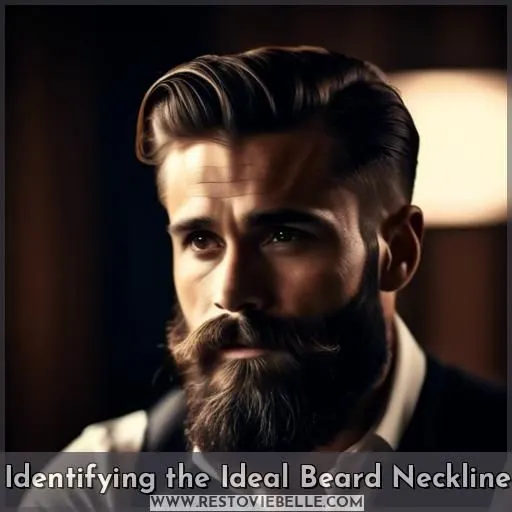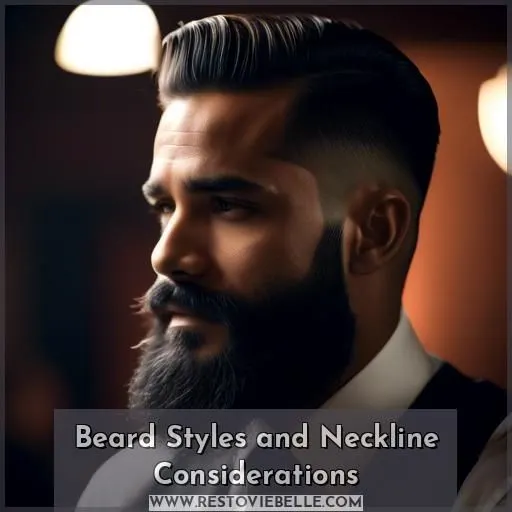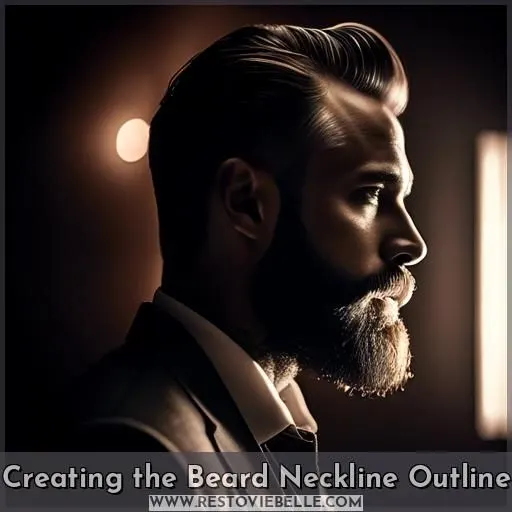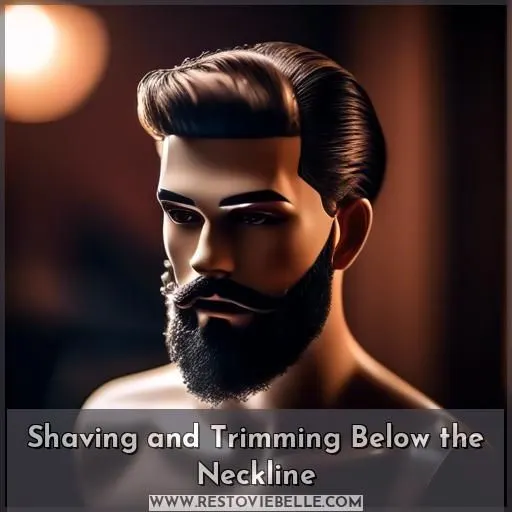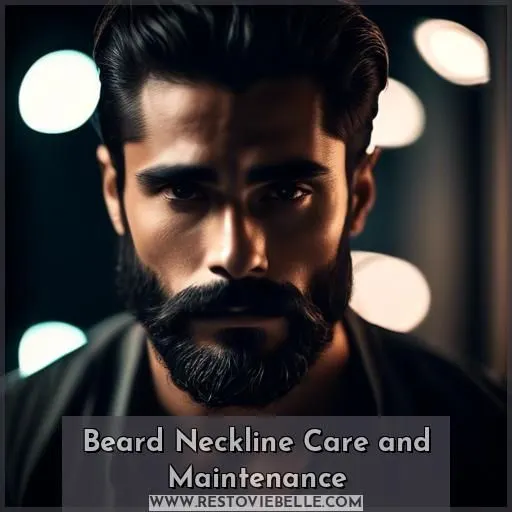This site is supported by our readers. We may earn a commission, at no cost to you, if you purchase through links.
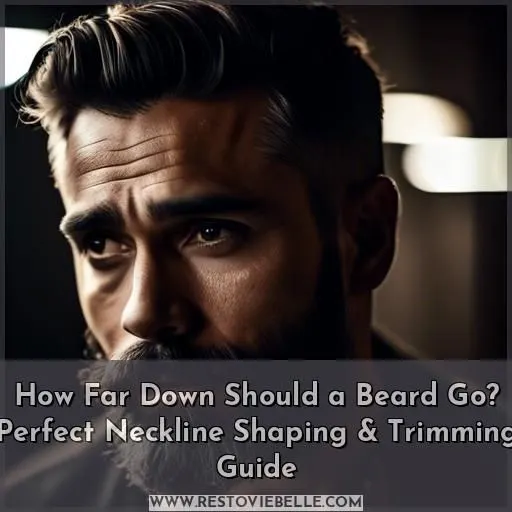
Your beard’s neckline should align with the top crisp crease of your neck, typically about 1-2 finger widths above your Adam’s apple.
Let the hair grow along your jawline’s natural curve, tapering down from the sideburns.
How far down should a beard go?
Too high, and you risk an unkempt neckbeard look; too low, and it appears sloppy.
A well-defined neckline accentuates your jawline, frames your face, and achieves a polished appearance.
To perfect your neckline shaping, the techniques involve locating the ideal lines, using precision trimmers, and regularly maintaining crisp edges.
Table Of Contents
Key Takeaways
- The ideal beard neckline aligns with the top crisp crease of the neck, typically 1-2 finger widths above the Adam’s apple.
- A well-defined neckline accentuates the jawline, frames the face, and avoids an unkempt neckbeard look.
- The neckline height should be adjusted based on the desired beard shape and face shape to achieve a harmonious appearance.
- Regular maintenance and precision trimming are essential for maintaining a clean, polished neckline.
How Far Down Should a Beard Go?
A beard should typically extend to just above the Adam’s apple, creating a U shape from earlobe to earlobe. The neckline should be trimmed to create a seamless integration between the beard and neck.
Identifying the Ideal Beard Neckline
The ideal beard neckline is a significant consideration in attaining a well-manicured and appealing beard style. Correctly identifying and defining the neckline will assist in highlighting your facial features, harmonizing with your beard length and shape, and averting an untidy or unnatural demeanor.
Definition and Importance
Your beard neckline is the lowest point of beard growth, typically around the midpoint of your neck.
It’s essential for preventing unkempt neckbeards and emphasizing gray hairs or patchy growth.
A well-defined neckline enhances your beard style.
To determine your ideal beard neckline, consider your desired beard shape, outlining the top and bottom of the neckline.
Use a pencil to find the deepest hollow of your cheekbones.
Locate the Adam’s apple and measure two fingers above for the bottom of your neckline.
Remember to avoid setting your neckline too high, as this can create an unnatural angular beard line.
Use precision trimming attachments for shaping.
Locating Your Beard Neckline
To locate your beard neckline, start by determining your desired beard shape, whether round or square.
Outline the top and bottom of your neckline, using a pencil to find the deepest crevice of your cheekbones.
Draw a line from your tragus of your ear to the corner of your mouth.
Locate your Adam’s apple and measure two fingers above for the bottom of your neckline.
Use an electric edger to create the initial outline, defining your jawline and bone structure.
Use trimmers for control, clippers or shears for longer beards.
Position yourself at a profile view in the mirror and shave the neckline for a cleaner look.
Remember to avoid setting the neckline too high, as this can create an unnatural angular beard line.
Use precision trimming attachments for shaping, and experiment with different beard styles to find the best fit for your face shape and beard length.
Beard Styles and Neckline Considerations
Your beard style should complement your face shape for an aesthetically pleasing look. For instance, a rounded neckline softens angular faces, while more defined lines accentuate stronger jawlines. Adjusting the neckline is essential when growing a longer beard; failing to do so can result in an unkempt neckbeard appearance that detracts from the overall style.
Matching Beard Style to Face Shape
To match your beard style to your face shape, consider the following guidelines:
- Oval Face: Your versatile face shape allows you to experiment with a variety of beard styles, from full beards to classic goatees and well-groomed stubble. Focus on maintaining a balanced look by trying different lengths and shapes to complement your features.
- Round Face: Opt for beard styles that elongate your face, such as an extended goatee or a slightly longer, more structured beard. Avoid overly full and rounded beard shapes, as they can make your face appear rounder.
- Square Face: Soften your features by choosing beard styles that add curves to your face, like a short boxed beard or a beard with rounded edges. This will create a harmonious balance between your facial structure and your beard.
- Heart Face: Aim for beard styles that achieve balance and add volume to the chin area. Consider a chinstrap beard or a light stubble to draw attention away from the wider forehead and toward the chin, creating a more harmonious look.
- Diamond Face: To complement a diamond face shape, choose beard styles that reduce the appearance of a wider cheekbone area. Consider a shorter beard with less volume on the sides, which will help balance your facial proportions and accentuate your unique features.
Adjusting Neckline for Beard Length
When pondering how far down your beard should go, consider the beard length as your roadmap.
A chin line finish can border on theatrical, while mustache-less beards risk the creepy factor.
Aim for a natural beard fade that complements your features.
Don’t let your beard wander into neckbeard territory; it’s a journey no one should take.
Regular use of beard wash, balm, and oil will keep your facial forest in peak condition.
Creating the Beard Neckline Outline
To create a precise beard neckline outline, you’ll need the right tools. Invest in quality trimmers with adjustable guards for precision edging and contouring around the neckline. Carefully follow your jaw’s natural curves and bone structure, using a mirror and profile views to outline the desired shape – whether rounded or angular to complement your face.
Tools for Precision
To achieve a perfectly trimmed beard neckline, it’s crucial to employ the appropriate instruments for precision.
Electric edgers and precision trimming attachments are ideal for delineating the neckline and contouring the beard. These tools are specifically engineered for neck trimming, enabling a pristine and well-defined appearance. Moreover, they can assist in preventing razor bumps and ingrown hairs, which are prevalent issues when trimming the neckline.
Beard transplant procedures may also be necessary for those experiencing substantial hair loss or patchy growth in the beard area.
Remember to clean and replenish blades regularly to preserve the efficacy of your grooming tools.
Shaping Techniques
To achieve an ideal beard neckline, you’ll need to master the art of shaping techniques.
The neckbeard prevention method involves defining the lowest point of your beard growth, typically around the midpoint of your neck. This is where your beard meets the neckline, ensuring a clean and polished look.
When locating your neckline, consider the line between the lowest points of your ears, which should meet at your Adam’s apple. For a more natural look, aim two fingers above your Adam’s apple.
To create the outline, use precision trimming attachments or electric edgers.
For jawline definition, consider a sharper-edged style with a rounded neckline.
To enhance your beard style, experiment with different neckline heights.
Beard oil conditioning can help maintain the health of your beard and prevent unkempt growth.
Shaving and Trimming Below the Neckline
You’ll want to avoid the common mistake of shaving too high above the Adam’s apple, as this can create an unnatural and unflattering line. To achieve a clean shave below the neckline, use short, precise strokes with a sharp razor, applying gentle pressure and shaving with the grain of your hair growth.
Avoiding Common Mistakes
To avoid common mistakes when shaving and trimming below the neckline, follow these tips:
- Avoid setting the neckline too high: This can result in an unnatural angular beard line, which may not suit your face shape or style. Aim for a neckline that’s around the midpoint of your neck, where your head connects to your neck.
- Use precision trimming attachments: These are designed for contour edging and fading beard lines, making them ideal for neck trimming. Explore a range of beard trimming tools and attachments to find the best fit for your needs.
- Avoid pressing too hard with shaver or trimmer: This can cause razor burn or ingrown hairs, which can be painful and unsightly. Be gentle when shaving or trimming below the neckline.
Techniques for a Clean Shave
To achieve a clean shave below the neckline, start with the right tools.
Use a Philips Norelco OneBlade Face + Body or a Panasonic Cordless Men’s Beard Trimmer for precision.
Soften your skin with hot water or conditioner before shaving.
Apply a gentle cleanser to remove ingrown hairs, then rub it in a circular motion to release trapped hairs.
Shave with the grain, after a warm towel or shower, to minimize skin irritation.
For neck contours, use an electric edger for precision.
Shave the neckline to define your beard shape, using trimmers, clippers, or shears depending on beard length.
Beard Neckline Care and Maintenance
Proper beard neckline care and upkeep is essential to prevent razor irritation and maintain a polished appearance. Regularly cleaning your beard and hydrating the skin beneath will avert ingrown hairs, discomfort, and unsightly redness along the neckline.
Treating Razor Burn
Razor burn is a common problem for those who shave regularly. It can be caused by shaving against the grain, using dull razors, and not properly preparing the skin before shaving.
To treat razor burn, start by using a gentle cleanser to remove any ingrown hairs and soothe the skin. Avoid pressing too hard with your razor or trimmer, and rinse your blades frequently to prevent buildup.
If you’re prone to razor burn, consider using a shaving cream or gel that contains aloe vera or calendula to help soothe the skin. Exfoliating with salicylic acid or glycolic acid can help prevent razor bumps by keeping dead skin cells from clogging hair follicles.
Additionally, give your skin a break by not shaving every day, especially if you have sensitive skin.
Regular Cleaning and Moisturizing
To keep your beard looking sharp and healthy, regular cleaning and moisturizing are essential.
Start by using a high-quality beard oil that contains ingredients like shea butter and glycolic acid. This will help condition your beard and keep it soft.
After shaving, clean your beard with a gentle cleanser to remove any ingrown hairs or debris. Be sure to exfoliate regularly to prevent razor burn.
When shaving, always use a fresh blade and shave with the grain. If you’re using an electric edger, go for definition when trimming.
The key to a great beard isn’t just how it looks, but how it makes you feel. So take care of your beard, and it will take care of you.
Conclusion
Perfecting your beard’s neckline is akin to framing a masterpiece.
With precision and care, you accentuate your jawline’s contours.
Regularly revisit the crisp lines.
Employ the right tools to expertly shape and trim below where your beard should go.
A well-defined neckline elevates your grooming regimen.
It ensures a polished, consistent appearance that commands attention.
Maintaining those clean edges requires diligence.
The payoff is a beard that exudes confidence and sophistication.
